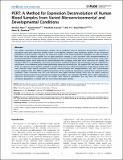PERT: A Method for Expression Deconvolution of Human Blood Samples from Varied Microenvironmental and Developmental Conditions
Author(s)
Qiao, Wenlian; Quon, Gerald; Csaszar, Elizabeth; Yu, Mei; Morris, Quaid D.; Zandstra, Peter W.; ... Show more Show less
DownloadQiao-2012-PERT_ A Method for E.pdf (1.416Mb)
PUBLISHER_CC
Publisher with Creative Commons License
Creative Commons Attribution
Terms of use
Metadata
Show full item recordAbstract
The cellular composition of heterogeneous samples can be predicted using an expression deconvolution algorithm to decompose their gene expression profiles based on pre-defined, reference gene expression profiles of the constituent populations in these samples. However, the expression profiles of the actual constituent populations are often perturbed from those of the reference profiles due to gene expression changes in cells associated with microenvironmental or developmental effects. Existing deconvolution algorithms do not account for these changes and give incorrect results when benchmarked against those measured by well-established flow cytometry, even after batch correction was applied. We introduce PERT, a new probabilistic expression deconvolution method that detects and accounts for a shared, multiplicative perturbation in the reference profiles when performing expression deconvolution. We applied PERT and three other state-of-the-art expression deconvolution methods to predict cell frequencies within heterogeneous human blood samples that were collected under several conditions (uncultured mono-nucleated and lineage-depleted cells, and culture-derived lineage-depleted cells). Only PERT's predicted proportions of the constituent populations matched those assigned by flow cytometry. Genes associated with cell cycle processes were highly enriched among those with the largest predicted expression changes between the cultured and uncultured conditions. We anticipate that PERT will be widely applicable to expression deconvolution strategies that use profiles from reference populations that vary from the corresponding constituent populations in cellular state but not cellular phenotypic identity.
Date issued
2012-12Department
Massachusetts Institute of Technology. Computer Science and Artificial Intelligence LaboratoryJournal
PLOS Computational Biology
Publisher
Public Library of Science
Citation
Qiao, Wenlian et al. “PERT: A Method for Expression Deconvolution of Human Blood Samples from Varied Microenvironmental and Developmental Conditions.” Ed. Richard Bonneau. PLoS Computational Biology 8.12 (2012): e1002838. CrossRef. Web.
Version: Final published version
ISSN
1553-734X
1553-7358